Purpose
Vessel Traffic Service or VTS is a shore-based system implemented by a competent authority to:
- Improve the safety and efficiency of navigation,
- Safety of life at sea, and
- Protection of the marine environment.
VTS is governed by SOLAS Chapter V Regulation 12 together with the guidelines for Vessel Traffic Services [ IMO Resolution A.857(20) ] adopted on 27 November 1997.
A Vessel traffic image is compiled and collected by means of advanced sensors such as radar, AIS, direction finding, CCTV and VHF or other cooperative system services. A modern VTS integrates all information into a single operator screen i.e his working environment for ease of use and in order to allow for effective traffic organisation and communication.
In areas that are covered with VTS, there are certain procedures for vessels to follow such as Area Procedures, Sector Areas, Arrival and Departure Reports, Approach Procedures, Pilotage Procedures and many more. Each of the above procedures is named with respect to the area that they serve. For eg. in Norway, Oslofjord the Area Procedures are called “OSL1” and “OSL3” and in the Netherlands, Rotterdam, Maas Approach and Maas Entrance are called “RTM2” and “RTM6” respectively.
A VTS should always have a comprehensive traffic image, which means that all factors influencing the traffic as well as information about all participating vessels and their intentions should be readily available. By means of these images, the situations that are developing can be evaluated and responded upon. The Data evaluation depends to a great extent on the quality of the data that is collected and the ability of the operator to combine this with an actual or developing situation. The data dissemination process exists of conveying the conclusions of the operator.
When approaching or in a VTS Area:
Generally, ships entering a VTS area report to the authorities, usually by radio, and may be tracked by the VTS control centre.
Ships must keep watch on a specific frequency for navigational or other warnings, while they may be contacted directly by the VTS operator if there is a risk of an incident or, in areas where traffic flow is regulated, to be given advice on when to proceed.

Original Image Courtesy: www.southamptonvts.co.uk
Definitions
- Competent authority – the authority made responsible, in whole or in part, by the Government for safety, including environmental safety, and efficiency of vessel traffic and the protection of the environment.
- VTS authority – the authority with responsibility for the management, operation and coordination of the VTS, interaction with participating vessels and the safe and effective provision of the service.
- VTS area – the delineated, formally declared service area of the VTS. A VTS area may be subdivided into sub-areas or sectors.
- VTS centre – the centre from which the VTS is operated. Each sub-area of the VTS may have its own sub-centre.
- VTS operator – an appropriately qualified person performing one or more tasks contributing to the services of the VTS.
- VTS sailing plan – a plan which is mutually agreed between a VTS Authority and the master of a vessel concerning the movement of the vessel in a VTS area.
- VTS traffic image – the surface picture of vessels and their movements in a VTS area.
VTS Services
VTS should comprise at least an information service and may also include others, such as a navigational assistance service or a traffic organization service, or both, defined as follows:
Information Service
An information service is a service to ensure that essential information becomes available in time for on-board navigational decision making. This information service is provided by broadcasting information at fixed times and intervals or when deemed necessary bt VTS or at the request of the vessel. For example, reports on the position, identity and intentions of traffic; waterway conditions; weather; hazards; or any other factor that may influence vessel’s transit.
Traffic Organisation Service
A Traffic organisation service is a service to prevent the development of dangerous maritime traffic situations and to provide for the safe and efficient movement of vessel traffic within the VTS area. The traffic organisation service concerns the operational management of traffic and the forward planning of vessel movements to prevent congestion and dangerous situations and is particularly relevant in times of high traffic density or when the movement of special transports may affect the flow of the traffic.
Navigational Assistance Service
A navigational assistance service is a service to assist on-board navigational decision making and to monitor its effects. The navigational assistance service is essentially important in difficult navigational or meteorological circumstances or in case of defects or deficiencies. This service is normally rendered at the request of a vessel or by the VTS when deemed necessary.
When the VTS is authorized to issue instructions to vessels, these instructions should be result-oriented only, leaving the details of execution, such as course to be steered or engine manoeuvres to be executed, to the master or pilot on board the vessel. Care should be taken that VTS operations do not encroach upon the master’s responsibility for safe navigation, or disturb the traditional relationship between master and pilot.
A VTS area can be divided into sectors, but these should be as few as possible. Area and sector boundaries should not be located where vessels normally alter course or manoeuvre or where they are approaching areas of convergence, route junctions or where there is crossing traffic. VTS centres in an area or sector should use a name identifier. The boundaries should be indicated in the appropriate nautical publications and in the “World VTS Guide“.
Communication and Reporting
Communication between a VTS authority and a participating vessel should be conducted in accordance with the Guidelines and Criteria for Ship Reporting systems and should be limited to information essential to achieving the objectives of the VTS. IMO Standard Marine Communication Phrases should be used where practicable. In any VTS message directed to a vessel or vessels, it should be made clear whether the message contains information, advice, warning, or an instruction.
Organization
Elements of a VTS
In order to perform the required tasks, a VTS organization requires adequate staff, housing, instrumentation and procedures governing operations and interactions between the various elements. The requirements in each field are determined by the particular nature of the VTS area, the density and character of the traffic and the type of service that is to be provided. Consideration should be given to the establishment of back-up facilities to sustain and maintain the desired level of reliability and availability.
Tasks performed by a VTS
A VTS should at all times be capable of generating a comprehensive overview of the traffic in its service area combined with all traffic influencing factors. The VTS should be able to compile a traffic image, which is the basis for its capability to respond to traffic situations developing in its service area. The traffic image allows the VTS operator to evaluate situations and make decisions accordingly. Data should be collected to compile the traffic image includes:
- data on the fairway situation, such as meteorological and hydrological conditions and the operational status of aids to navigation;
- data on the traffic situation, such as vessel positions, movements, identities and intentions with respect to manoeuvres, destination and routing;
- data of vessels in accordance with the requirements of ship reporting and if necessary any additional data, required for the effective operation of the VTS.
Operating procedures
Where operating procedures are concerned, a distinction should be made between internal and external procedures. Internal procedures cover operating instruments, interactions among the staff and the internal routing and distribution of data. External procedures cover interactions with users and allied services. A further distinction should be made between procedures governing the daily routine and procedures governing contingency planning such as search and rescue and environmental protection activities. All operational procedures, routine or contingency, should be laid down in handbooks or manuals and be an integral part of regular training exercises. Adherence to procedures should be monitored.
Database
A VTS authority should have, if necessary for the operation of the service, a database with the capacity to retain, update, supplement and retrieve data once collected. Any data retained in a system for further use should be made available only on a selective and secure basis.
Participating vessels
Vessels navigating in an area where vessel traffic services are provided should make use of these services. Depending upon governing rules and regulations, participation in a VTS may be either voluntary mandatory. Vessels should be allowed to use a VTS where mandatory participation is not required.
Decisions concerning the actual navigation and the manoeuvring of the vessel remain with the master.
Neither a VTS sailing plan nor requested or agreed on changes to the sailing plan can supersede the decisions of the master concerning the actual navigation and manoeuvring of the vessel.
- Communication with the VTS and other vessels should be conducted on the assigned frequencies in accordance with established ITU and SOLAS chapter IV procedures, in particular where a communication concerns intended manoeuvres.
- VTS procedures should stipulate what communications are required and which frequencies should be monitored. Prior to entering the VTS area, vessels should make all required reports, including reporting of deficiencies. During their passage through the VTS area, vessels should adhere to governing rules and regulations, maintain a continuous listening watch on the assigned frequency and report deviations from the agreed sailing plan, if such a plan has been established in co-operation with the VTS authority.
- Masters of vessels should report any observed dangers to navigation or pollution to the VTS centre.
- In case of a complete failure of the vessel’s appropriate communication equipment the master shall endeavour to inform the VTS centre and other vessels in the vicinity by any other available means of communication of the vessel’s inability to communicate on the assigned frequency. If the technical failure prevents the vessel from participation or continuing its participation in a VTS, the master should enter in the vessel’s log the fact and reasons for not or further participating.
- Vessels should carry publications giving full particulars on governing rules and regulations regarding identification, reporting and/or conduct in the VTS area to be entered.
Further Information
SOLAS Ch V Regulation 12 – Vessel Traffic Services
- Vessel traffic services (VTS) contribute to safety of life at sea, safety and efficiency of navigation and protection of the marine environment, adjacent shore areas, work sites and offshore installations from possible adverse effects of maritime traffic.
- Contracting Governments undertake to arrange for the establishment of VTS where, in their opinion, the volume of traffic or the degree of risk justifies such services.
- Contracting Governments planning and implementing VTS shall, wherever possible, follow the guidelines developed by the Organization. The use of VTS may only be made mandatory in sea areas within the territorial seas of a coastal State.
- Contracting Governments shall endeavour to secure the participation in, and compliance with, the provisions of vessel traffic services by ships entitled to fly their flag.
- Nothing in this regulation or the guidelines adopted by the Organization shall prejudice the rights and duties of Governments under international law or the legal regimes of straits used for international navigation and archipelagic sea lanes.
Summary
- Contracting Governments to establish VTS where traffic volume or risks justify it.
- VTS to follow guidelines adopted by IMO.
- VTS can only be mandatory in territorial seas.
- Ships to be encouraged by Administrations to use VTS.

Such a cool article. You should consider showing the authors names or references for quotes and citations on papers and articles.